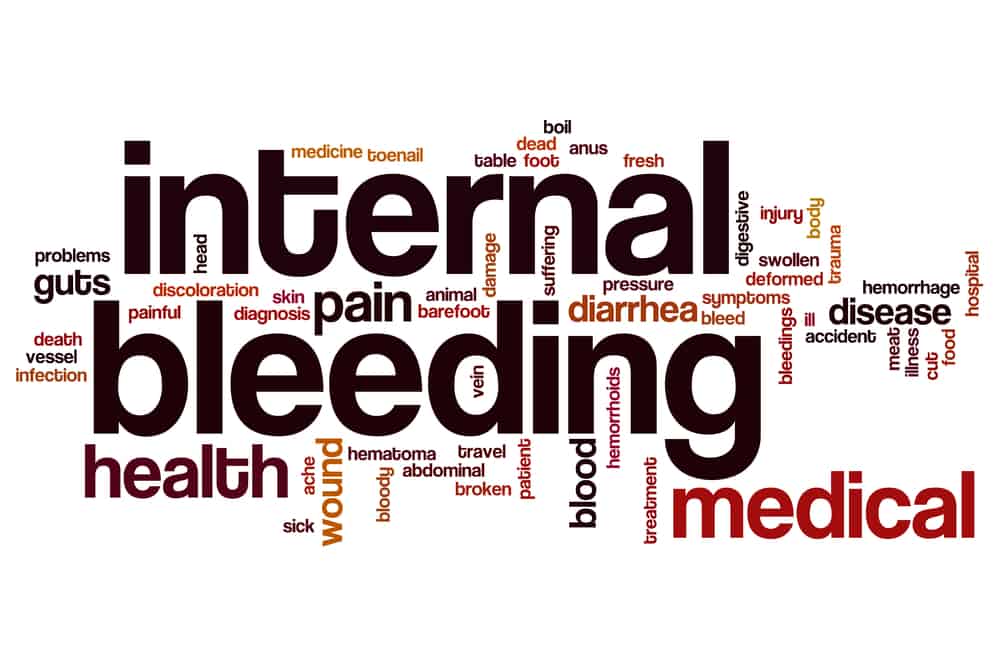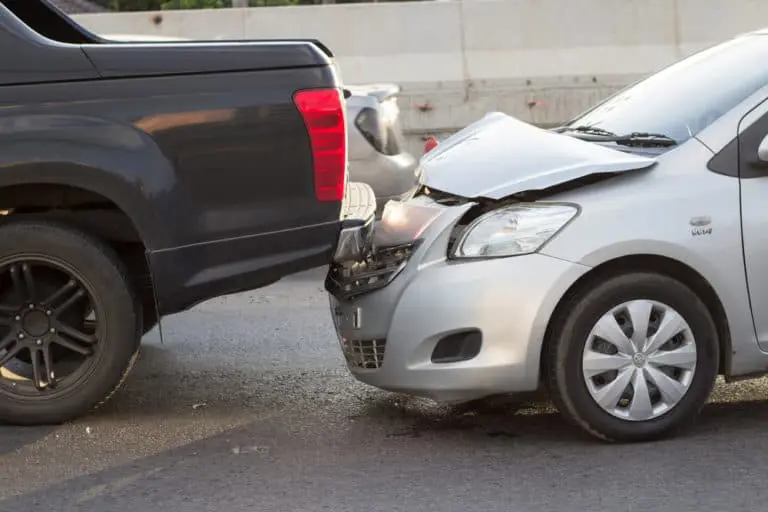After you walk away from a car accident, whether it was a small fender bender or a severe incident that totaled your car, it is important to determine whether or not you have been injured. Some people are able to walk away with nothing more than a few little scrapes, while others may think they are well at first, only to realize that they have a case of internal bleeding that, without treatment, could prove fatal.
Internal bleeding often passes under the radar because it can be so difficult to see. After all, an injury to your skin or some other visible part of your body is easy to recognize and thus more easily treated. Internal bleeding is not as easy to see, and its symptoms may be mistaken for other conditions. Be sure to set forth on your post-accidental medical journey with a strong dose of suspicion, advocating for yourself with your medical team. It is important to follow up days or even weeks after your accident to rule out potential car accident injuries that may have caused internal bleeding.
Warning Signs and Symptoms
If you are dealing with internal bleeding, you may experience some or all of the following symptoms. The symptoms listed here are shared by many different forms of internal bleeding. You may find more specific symptoms related to specific internal bleeding areas further down in this article.
- Sudden vertigo (dizziness), especially when you move from sitting to standing
- Weakness or muscle fatigue
- Syncope (fainting or passing out)
- Low blood pressure, especially if that is not part of your normal health history
- New or sudden vision problems
- Numbness or tingling in your fingers or toes
- Weakness that is more apparent on one side of your body
- Severe, sudden headaches that do not go away with pain relievers
- Shortness of breath
- Pain in your chest
- New gastrointestinal problems, including nausea, vomiting, and diarrhea
Another important symptom to look out for, especially if you have experienced trauma to the stomach area, is blood in your stool or vomit. This could be red like fresh blood, or it could color your stool or vomit black. In the case of stomach trauma, you may also have bruising on your abdomen or around your navel (belly button). If you are experiencing these symptoms, seek medical care immediately. You may be experiencing gastrointestinal bleeding, one of the more serious forms of internal bleeding.
Shock
It is important to look out for shock as a result of internal bleeding. Shock is a serious, critical condition that occurs as a result of lessened blood flow throughout the body. In the case of internal bleeding, shock happens when bleeding begins abruptly and intensifies quickly. Shock is characterized by the following symptoms:
- A sudden drop in blood pressure
- Problems with urinating, including urinating less frequently than normal, or sometimes not at all
- Sudden changes in behavior, such as extreme anxiety
- Enlarged pupils
- Cool, clammy skin and/or pale or ashen skin
- For light-skinned people, a bluish hue in lips or fingernails; for darker-skinned people, a more gray tinge to these areas
- Rapid pulse and breathing
- Unconsciousness
When you are in shock, your organs are not receiving the necessary amount of oxygen to function properly. If left too long, shock can end in organ damage or failure, and it can ultimately be fatal.
If you suspect you may be in shock, call your local emergency number immediately. There are first aid steps you can take to care for yourself until emergency personnel arrive, or better yet, have someone trained in first aid care help you.
Forms of Internal Bleeding
Internal bleeding can happen to many different organs within your body, depending on where you sustained trauma during a car accident (or another incident that led you to develop internal bleeding symptoms).
Bleeding in the Brain
When internal bleeding occurs in your head, you may have what is called a traumatic brain injury. These are serious injuries that could impair many areas of your life, especially if left untreated. Traumatic brain injuries need to be treated by a doctor immediately upon noticing signs and symptoms. Some effects of traumatic brain injuries include cognitive dysfunction, disruptions to sensory processing, significant behavior and mental health problems, and even conditions like paralysis and coma. It is especially important to have your eye out for symptoms of internal bleeding in the brain if you experienced any hit to the head during your car accident. The symptoms, which can be anywhere from very mild to severe, are as follows:
- Loss of consciousness
- Headache
- Confusion
- Lightheadedness or dizziness
- Blurred vision
- Tinnitus (ringing in the ears)
- Bad taste in the mouth
- Sudden fatigue or lethargy
- A new difficulty with memory, attention, or focus
- Sleep disturbances
More severe cases of internal bleeding in the head can include seizures, dilation of the pupils, slurred speech, weakness, tingling, or numbness in your fingers and toes, and increased agitation.
Gastrointestinal Internal Bleeding
If you sustained blunt force to your chest or abdomen during your car accident, you might be experiencing internal bleeding in those areas. Gastrointestinal bleeding refers to an internal bleeding injury in your digestive tract. These symptoms can also range from mild to severe. Medically, there are two ways that internal bleeding in the gastrointestinal tract may manifest: obvious symptoms are referred to as overt, while hidden symptoms are referred to as occult.
Overt symptoms can include the above-mentioned black or tarry stools or obvious blood in your stool or vomit. Blood in vomit can be brown in color and textured like coffee grounds. There may also be rectal bleeding.
Occult symptoms are more difficult to connect outright with internal bleeding. These symptoms can include lightheadedness, shortness of breath, fainting, and pain in the chest or abdomen.
If you do not seek medical attention for potential internal bleeding injuries, you may experience shock, anemia, or even death.
Internal Bleeding in Joints or Muscles
Sometimes, instead of getting a cut, scrape, or bruise, trauma to your limbs or other muscles can cause internal bleeding. You may also experience internal bleeding in a joint or in any of the tendons or connective tissues that hold your skeleton together. If you are experiencing internal bleeding in these areas, your symptoms may include pain in the joints or muscles or a decrease in your range of motion in the affected area.
Causes of Internal Bleeding
Of course, car accidents and injuries related to car accidents are significant contributors to internal bleeding problems. In fact, cases of blunt abdominal trauma are usually sustained during motor vehicle accidents. This kind of trauma also includes falls from significant heights, sports-related injuries, bicycle accidents, and accidents that occur during industrial work.
Another concern is traumatic brain injuries, or TBIs. In fact, motor vehicle accidents are the cause behind over a quarter of traumatic brain injury patients hospitalized each year. These kinds of car accident injuries can affect passengers in cars, motorcyclists, and pedestrians.
Some forms of internal bleeding may occur due to a pre-existing condition or predisposition that is then exacerbated by a car accident injury.
Risk Factors
According to the Center for Disease Control (CDC), which collects annual data on fatalities and injuries resulting from car accidents, over two million people visit the emergency room due to car accident injuries every year in the United States. Women tend to be particularly at risk, with data showing that women are up to 73% more likely to be injured in a car crash than men.
There are also risk factors that relate specifically to internal bleeding. You may be more likely to sustain an internal bleeding injury if you have a disorder that causes your blood to clot less quickly. Certain medications such as blood thinners (including aspirin) can contribute to internal bleeding, as well as putting you more at risk for damage to the lining of your stomach.
When you are in a car accident, any form of trauma, regardless of the level of force, can result in internal bleeding. It is possible to have an internal bleeding injury without puncturing the skin. The more force that was involved in your car crash – the more speed, the heavier the cars involved, whether your car received more of the impact – the more likely it is that you may have an internal bleeding injury.
Diagnosing Internal Bleeding
Because symptoms of internal bleeding are not always immediately apparent, it is important to seek medical attention quickly any time you have been in a car accident where you dealt with any blunt force striking part of your body.
In order for a doctor to diagnose your internal bleeding, it is likely that you will need to undergo some form of imaging, a thorough physical exam, and a battery of tests. Depending on the extent of your internal bleeding injury, an x-ray may be the only form of imaging that your doctor requires. For injuries that are more difficult to see on an x-ray, a computed tomography (CT) scan may be necessary. There is also a form of imaging called angiography that can help doctors individually examine each of your blood vessels.
There are also tests that can help doctors figure out where the bleed in your body is. There are also tests that can help them determine the severity of the bleeding.
Prevention
It isn’t just there for show – it is extremely important to wear a seatbelt when riding in a motor vehicle. In fact, riding in a car without a seatbelt nearly doubles your risk of death compared to wearing a seatbelt.
Another important preventive measure is to ensure that the car you buy or otherwise spend your most time driving has a strong rating in the area of injury prevention. Be aware that discrepancies in the kind of test dummies being used in car assessments may cause a woman in a car with a Good rating to be much more at risk for injury than a man in the same car.
Internal Bleeding Treatment
Sometimes, minor internal bleeding can stop by itself. In this case, you will be fine. However, you will need more intensive treatment for more severe cases of bleeding. The first thing that your doctor will want to do is to find the source of the internal bleeding and make the bleeding stop. It will not be possible to do any further treatment without this vital first step.
After the bleeding has stopped, your doctor will work on a plan, depending on the severity of the cause of the injury (for example, a fender bender versus a twelve car pileup), which organ has borne the brunt of the trauma, and the general level of your health. Your doctor will want to focus on stabilizing your body and making sure that the wound heals correctly.
No matter what your doctor’s other treatment plans entail, you will always be told that you need to rest. Rest will allow your body to redirect much-needed resources towards healing and will limit the chance of further complications as a result of the injury. It will help decrease the inflammation and ensure that the wound does not reopen.
After the wound has healed, you may need occupational, physical, or speech therapy, depending on your injury. These therapies will help you rehabilitate your previous quality of life.
Outlook and Next Steps
Even injuries that begin as minor forms of internal bleeding can have significant long-term effects if left untreated. It is important to see medical attention after a car accident so that a medical team can help rule out the potential for a case of internal bleeding.
If the internal bleeding is severe enough, you could end up in a coma and may even experience even worse outcomes – including death. That is why it is so necessary to ensure that you receive treatment right away.
However, with a healthy sense of urgency, and if you follow your doctor’s treatment plan, the outcome is most likely to be positive. Many people make a full recovery, and after that recovery, there are often no lasting effects.



